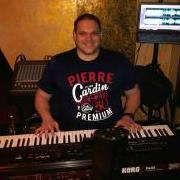Leaderboard
Popular Content
Showing content with the highest reputation on 04/15/2021 in all areas
-
Sometime, my teacher called something I wrote "abstract music" because it was not written with instrumental voices in mind, but rather as a compositional exercise(in counterpoint). Having no better term at hand, I tried to express that your composition is abstract from the guitar and its playing style(what I also called "unidiomatic"). I also partially listened to your Soliloquy No. 33 for Violin and felt like it was certainly playable on violin, but did not make use of its special techniques. I am no violinist, of course, so I am inclined to trust your experience as a cellist. Maybe a few notes may excuse my imprecise expression: - small melodic steps(jumps are perfectly playable as long as fingering is kept in mind) - mostly monophonic(the six strings permit proper accompaniment rather well) Combining just the two notes, it would be more idiomatic to begin the piece in a higher register(c' for example), so one could sprinkle in some bass notes to emphasize the harmony(A minor is strongly implied, I assume you had that in mind). Again, if you are not aiming for such a style of writing, I would not argue against that, but it certainly is the traditional style of writing for the guitar and something a performer would expect. Another thing I just stumbled upon, concerning your melodic writing: Between the third beat of m. 2 and the last beat of m. 3, you travel down a fifth almost in one jump and a ninth upwards in three consecutive jumps. Of course, melodies are to be judged by the ear, but such large (consecutive) jumps are traditionally discouraged because they are rather hard to sing(i. e. not naturally melodic) or, here at the very least, not used as as means of heightened expression. If I were to sketch the melodic outlines, this would certainly stand out visually while not giving a sense of a melodic peak. Additionally, your isorhythmic writing(all quarter notes in the first six bars) makes the melody rather tepid; I would try to incorporate a rhythm just as you do in ms. 9-11. Then again, Ms. 12 f. seem sparsely connected to those before. At the intersection of harmony and melody, your first six measures could also sound more compelling if the implied tonic was approached via its leading tone(just like in ms. 14 ff.). In essence, apart from what I told you in regards to how a guitarist would usually accompany himself to fill out the harmony, I would try to make the melody more interesting, especially rhythmically. Maybe you could also carve out a motif; I myself find the four consecutive notes in m. 7 rather memorable. After skimming three of your pieces, I sense you might benefit from coming back to something you wrote down and try to elaborate on it(melodically, rhythmically etc.). Hopefully, this does not sound harsh and you can make good use of advice.2 points
-
Hi everyone! This is a composition that I composed for my mid-year examinations in music! With much requests to convert the String Quartet Movement Octatonic into a full length string quartet, I have done so and this is the second movement of the newly-coined string quartet no. 3! (Currently in draft 1) The criteria for the work had to be: - Requires use of at least 1 contemporary technique in modes, rhythm, meter or pitch (I used whole tones and rhythmic counterpoint) - 25-30+ bars (39 bars in this composition, totally did not extend the meter of the last bar to fit the criteria hahaha) So the motifs I have used are: - widespread use of the interval 4ths in doubling and between notes - dotted rhythm with semiquaver accompaniment - high register tremolos with staggered entries in the instruments (to recreate ethereal feeling) - triplet scalic passages - this pitch and rhythmic motif and theme (in the image below) These motifs (apart from the last one) were first introduced in the introduction. Some other interesting considerations I took: - Used open strings in double stops to add resonance that contribute to ethereal feeling - High register tremolos as mentioned - Whole tone creates dreamy effect - The movement of many lines in rhythmic counterpoint in dissonance creates very ungrounded, free feeling especially when used in extreme registers - Opening and closing scalic lines between intruments emphasise whole tone nature to set mode clear to listener from start and sort of transition the listener in and out of the dream state. -Explored new techniques (sul tasto, left-hand pizz arco gliss) Let me know any feedback for this work! Would really appreciate the feedback as this is a work that will be accessed as part of my academic grade and perhaps GCSE A-Levels!1 point
-
1 point
-
1 point
-
Not sure how you're going to bring off the cello double stop in bar 2. If the low G# is tied, you'd be crossing a string to get to the A#. Did you mean to tie the D? It certainly has atmosphere but more ominous to me, the music you'd expect to find backing a Hammer Horror film with someone nervously exploring a crypt or set of untidy corridors. Where are you from? GCSE suggests the UK.1 point
-
First of all I'm from Australia so I reckon GSCE is sort of comparable to HSC? Its clear you had a criterion for this composition, and as a marker, you'd be hard pressed not to give you a great mark. You've clearly and obviously marked out the goals for the piece. The piece is quite dense throughout, in terms of compositional techniques. Markers like this- it is an obvious way to give marks. You've been quite smart with your chose of contrasting motif (m3) its a smart way to balance the density. careful using sul tasto in high registers. This is sometimes impossible (fingers hitting the bow) and a somewhat ineffective tone colour (not noticeable). Stylistically, I don't personally feel the etherealness or dream-like quality? To me, harmonics and broad, rich harmony show dreaminess 🤷 (this is subjective- everyone dreams differently lol) I'm not super well versed in Messiaen's music or style, but generally to me his music seems dense but ordered- it feels very clean. His polyphony acts a single unit, in yours it feels more separated and individualistic (melody and motifs being passed around)- closer to a post-romantic style. This is just something to think about for next time. What you've made is already great 👍 Side note, how are you finding Dorico I've been curious about it lol EDIT: its kinda funny to call it a Lento, when the subdivisions make it not seem that way at all lol. I just read that its the second movement, which makes a lot of sense, since it felt like it was in the middle of a piece, not a piece on its own. I forgot to mention that I enjoyed the ending m32-END 🙂1 point
-
It's an old rule in counterpoint, for writing polyphonic music. If you want to make a chorale or fugue, or any other contrapunctal piece using 2 or more independent voices, parallel fifths are one of the things that {historically} you're not allowed to use, if you want to follow the rules from the past; similarly, using parallel octaves is also against the rules. I believe it's outlined in detail in Johann Joseph Fux's book Gradus ad Parnassum, and most music theory books based off of its teachings. Of course, if you don't care about following the guidelines set out in these books, then there's no one stopping you from doing so (unless you're taking a counterpoint test in a class). However, as a relatively traditional composer, I tend to try to follow them, especially when I write chamber music, which is inherently polyphonic.1 point
-
I like it. got a nice cheerful feeling to it. At times it feels a little unbalanced (the lead around 2 mins in sounds a little too loud, for me) other than that- perfect. It's a good work, seems to fit well in this category. @VovaTrykoz1 point
-
1 point
-
1 point
-
It breaks off leading into an interrupted cadence, a returne to sustained cello to finally resolve in a perfect or imperfect cadence depending what you want to do next. The 5ths in bar 4 sound clumsy. One possibility is to write the cello part as Ab (dotted crotchet) Gb F Db C Eb (all quavers).1 point
-
1 point
-
this is my new piece in minimal style, hope you like it, you can give me some suggestion if you like. the video: https://www.bilibili.com/video/BV1Zv411h7ZN/1 point
-
I wouldn't say the there's a problem with music theory, but rather your approach to it. I used to feel the same way, because what drives me as a musician is this ridiculous need to convey the sounds that I hear in my head to portray what I want to say. I used to start with music theory and try and fit ideas into it, but then I started letting that mental voice take charge, and using music theory to figure out where it's trying to go and what the actual goal is.1 point





.png.64dc2803a42a5a727765e909bddc6538.png)



